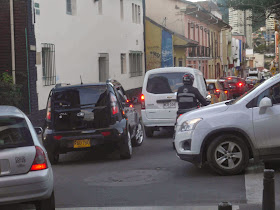 |
| NQS avenue this afternoon. |
 |
| The same stretch of the NQS Avenue on a normal day. |
 |
| Palo Quemao's Market's empty parking lot. |
That seemed to be the case today, during Mayor Petro's new, extra Car-Free Day, when much of the city seemed somewhat ghostly.
Don't get me wrong: I believe that cars are a scourge on cities and the planet, and I wish that every city was car-free every single day. However, Bogotá's car-free days seem mostly to generate resentment against such top-down sustainable transit measures, while changing the behavior of few people.
Petro has proposed creating monthly Car-Free Days. That will only add an additional day off or work-at-home day for many people. Better, but even less politically possible, would be to create a Car-Free Week, which would obligate drivers to find a more sustainable way to get around.
At this point, I can't help recalling an anecdote from the time car-choked Caracas, Venezuela
 |
| A normal, grid-locked day in La Candelaria. |
I knew a woman there who normally drove alone in her car from the city's outskirts to her office job in central Caracas, a miserable three-hour ordeal off traffic jams. During the petroleum strike she could not get gasoline and was forced - god forbid - to take the bus - and three separate buses, in fact. But despite that multi-bus odyssey, with the roads clear, my acquaintance got to work faster by bus than she had driving her car.
I'm sure that many people had similar experiences. Nevertheless, once the oil started flowing again, the immense traffic jams returned.
Should Bogotá shut down its gas stations? It could be a good thing, but not likely. Better for the city to triple the price of gasoline, or do what Petro said he would upon being elected: Create a London-style congestion charge.
That could really reduce the driving habit.
According to El Tiempo, bicycle - or, bike parking lot - use rose 9.2%, SITP bus use rose 19% and pollution dropped 15%.
By Mike Ceaser, of Bogotá Bike Tours
As a cyclist I love the car-free days but it does not make sense if businesses and offices just shut for the day. People I know employed by the state were instructed to ´work from home´ yesterday. Making the ciclorutas safer and less cluttered, and more proper bike parking racks would be a more positive way to get people traveling by bike. I chained my bike to a lamp-post recently and the transit police threatened to cut it free and confiscate it. What attitude is that!
ReplyDeleteOn "El Espectador" there was one journalist complaining that people had to wait 10-15 minutes for bus-Transmilenio to pass. That is exactly what usually people without car have to go through all days of the week, and, nevertheless, they get to destination faster than with car. So, better to wait Transmilenio or wait on the road, with the engine turn on, polluting and risking accidents? Anyhow, I do not know how is the situation for commuters who come from Chia, Cajica and other cities around big Bog...
ReplyDeleteHi Enrico - Your story just illustrates how people use cars for reasons that aren't very rational, such as status. In any case, it's just the fact that so many people insist on driving, often unnecessarily, that turns this city into a vast, polluted parking lot. Even tho many cars are relatively low emission (altho most seem to lack catalytic converters) the traffic jams they generate compound the pollution problem.
ReplyDeleteMike
Hi Mitzi,
ReplyDeleteYou've hit the issue right on the nose. If people just stay home on car-free day, they learn no lesson about sustainable commuting.
I've had the same experience with bike parking in public places. There's often a paranoia about bikes, whereas cars are welcomed and subsidized with free parking.
Mike